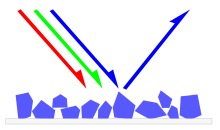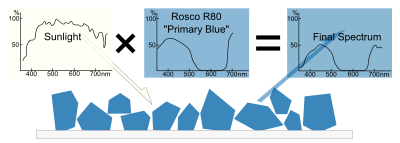Pigment

A pigment is a powder used to add color or change visual appearance. Pigments are completely or nearly insoluble and chemically unreactive in water or another medium; in contrast, dyes are colored substances which are soluble or go into solution at some stage in their use.[1][2] Dyes are often organic compounds whereas pigments are often inorganic. Pigments of prehistoric and historic value include ochre, charcoal, and lapis lazuli.
Economic impact
In 2006, around 7.4 million tons of inorganic, organic, and special pigments were marketed worldwide.[3] According to an April 2018 report by Bloomberg Businessweek, the estimated value of the pigment industry globally is $30 billion. The value of titanium dioxide – used to enhance the white brightness of many products – was placed at $13.2 billion per year, while the color Ferrari red is valued at $300 million each year.[4]
Physical principles

Like all materials, the color of pigments arises because they absorb only certain wavelengths of visible light. The bonding properties of the material determine the wavelength and efficiency of light absorption.[5] Light of other wavelengths are reflected or scattered. The reflected light spectrum defines the color that we observe.
The appearance of pigments is sensitive to the source light. Sunlight has a high color temperature and a fairly uniform spectrum. Sunlight is considered a standard for white light. Artificial light sources are less uniform.
Color spaces used to represent colors numerically must specify their light source.

Other properties of a color, such as its saturation or lightness, may be determined by the other substances that accompany pigments. Binders and fillers can affect the color.
History
Minerals have been used as colorants since prehistoric times.
The first known synthetic pigment was
Because of the cost of
The discovery in 1856 of
- Paintings illustrating advances in pigments
-
The Milkmaid bymadder lake, as shown in the vibrant painting.[19]
-
Assunta, completed c. 1518.
-
Miracle of the Slave by Tintoretto (c. 1548). The son of a master dyer, Tintoretto used Carmine Red Lake pigment, derived from the cochineal insect, to achieve dramatic color effects.
-
Self Portrait by Paul Cézanne. Working in the late 19th century, Cézanne had a much broader palette of colors than his predecessors.
Manufacturing and industrial standards


Before the development of synthetic pigments, and the refinement of techniques for extracting mineral pigments, batches of color were often inconsistent. With the development of a modern color industry, manufacturers and professionals have cooperated to create international standards for identifying, producing, measuring, and testing colors.
First published in 1905, the Munsell color system became the foundation for a series of color models, providing objective methods for the measurement of color. The Munsell system describes a color in three dimensions, hue, value (lightness), and chroma (color purity), where chroma is the difference from gray at a given hue and value.
By the middle 20th century, standardized methods for pigment chemistry were available, part of an international movement to create such standards in industry. The International Organization for Standardization (ISO) develops technical standards for the manufacture of pigments and dyes. ISO standards define various industrial and chemical properties, and how to test for them. The principal ISO standards that relate to all pigments are as follows:
- ISO-787 General methods of test for pigments and extenders.
- ISO-8780 Methods of dispersion for assessment of dispersion characteristics.
Other ISO standards pertain to particular classes or categories of pigments, based on their chemical composition, such as ultramarine pigments, titanium dioxide, iron oxide pigments, and so forth.
Many manufacturers of paints, inks, textiles, plastics, and colors have voluntarily adopted the Colour Index International (CII) as a standard for identifying the pigments that they use in manufacturing particular colors. First published in 1925—and now published jointly on the web by the Society of Dyers and Colourists (United Kingdom) and the American Association of Textile Chemists and Colorists (US)—this index is recognized internationally as the authoritative reference on colorants. It encompasses more than 27,000 products under more than 13,000 generic color index names.
In the CII schema, each pigment has a generic index number that identifies it chemically, regardless of proprietary and historic names. For example,
Figures of merit
The following are some of the attributes of pigments that determine their suitability for particular manufacturing processes and applications:
- Lightfastness and sensitivity for damage from ultraviolet light
- Heat stability
- Toxicity
- Tinting strength
- Staining
- Dispersion (which can be measured with a Hegman gauge)
- transparency
- Resistance to alkalis and acids
- Reactions and interactions between pigments
Swatches
Swatches are used to communicate colors accurately. The types of swatches are dictated by the media, i.e., printing, computers, plastics, and textiles. Generally, the medium that offers the broadest gamut of color shades is widely used across diverse media.
Printed swatches
Reference standards are provided by printed swatches of color shades.
Plastic swatches
Companies manufacturing color masterbatches and pigments for plastics offer plastic swatches in injection molded color chips. These color chips are supplied to the designer or customer to choose and select the color for their specific plastic products.
Plastic swatches are available in various special effects like pearl, metallic, fluorescent, sparkle, mosaic etc. However, these effects are difficult to replicate on other media like print and computer display. Plastic swatches have been created by 3D modelling to including various special effects.
Computer swatches
The appearance of pigments in natural light is difficult to replicate on a
The following approximations assume a display device at
|
#990024
Tyrian red |
PR106 – #E34234
Vermilion (genuine)
|
#FFB02E
|
|---|
|
PB29 – #003BAF
Ultramarine blue
|
PB27 – #0B3E66
|
|---|
Biological pigments
In biology, a pigment is any colored material of plant or animal cells. Many biological structures, such as skin, eyes, fur, and hair contain pigments (such as melanin).
affects the level of melanin production in animals.Pigmentation in organisms serves many biological purposes, including camouflage, mimicry, aposematism (warning), sexual selection and other forms of signalling, photosynthesis (in plants), and basic physical purposes such as protection from sunburn.
Pigment color differs from structural color in that pigment color is the same for all viewing angles, whereas structural color is the result of selective reflection or iridescence, usually because of multilayer structures. For example, butterfly wings typically contain structural color, although many butterflies have cells that contain pigment as well.
Pigments by chemical composition
- aluminum powder[23]
- Barium: barium white (lithopone)
- cadmium orange, cadmium sulfoselenide
- ivory black(bone charcoal)
- Chromium pigments: chrome yellow and chrome green (viridian)
- cerulean blue, aureolin(cobalt yellow)
- Phthalocyanine Blue BN, Phthalocyanine Green G, verdigris
- burnt umber
- red lead, lead-tin yellow
- Manganese pigments: manganese violet, YInMn blue
- Mercury pigments: vermilion
- Sulfur pigments: ultramarine, ultramarine green shade, lapis lazuli
- Titanium pigments: titanium yellow, titanium white, titanium black
- zinc yellow
Biological and organic
- Biological origins: alizarin, gamboge, cochineal red, rose madder, indigo, Indian yellow, Tyrian purple
- Non-biological diarylide yellow
See also
Notes
- .
Dyes are colored substances which are soluble or go into solution during the application process and impart color by selective absorption of light. Pigments are colored, colorless, or fluorescent particulate organic or inorganic finely divided solids which are usually insoluble in, and essentially chemically unaffected by, the vehicle or medium in which they are incorporated.
- ISBN 3527306730.
- ^ Sahoo, Annapurna; Panigrahi, G. K. (1 September 2016). "A review on Natural Dye: Gift from bacteria" (PDF). International Journal of Business. 5 (9): 4909.
- ^ Schonbrun, Zach (18 April 2018). "The Quest for the Next Billion-Dollar Color". Bloomberg Businessweek. Retrieved 2 May 2018.
- ^ Thomas B. Brill, Light: Its Interaction with Art and Antiquities, Springer 1980, p. 204
- OCLC 936144129.
- ^ "Earliest evidence of art found". BBC News. 2 May 2000. Archived from the original on 3 June 2016. Retrieved 1 May 2016.
- ^ a b "Pigments Through the Ages". WebExhibits.org. Archived from the original on 11 October 2007. Retrieved 18 October 2007.
- ^ Lorelei H. Corcoran, "The Color Blue as an 'Animator' in Ancient Egyptian Art", in Rachael B.Goldman, (ed.), Essays in Global Color History: Interpreting the Ancient Spectrum (New Jersey: Gorgias Press, 2016), pp. 59–82.
- ISBN 0-691-02386-7.
- PMID 17173142.
- .
- PMID 34050218.
- ^ Lead white Archived 25 December 2015 at the Wayback Machine at ColourLex
- OCLC 936144129.
- ^ a b "History of Indian yellow". Pigments Through the Ages. Archived from the original on 21 December 2014. Retrieved 13 February 2015.
- ^ Prussian blue at ColourLex
- ISBN 0-393-02005-3.
- ^ Johannes Vermeer, The Milkmaid Archived 14 April 2015 at the Wayback Machine, ColourLex
- ^ "Dictionary of Color Terms". Gamma Scientific. Archived from the original on 20 August 2014. Retrieved 25 June 2014.
- ^ "Color Appearance". Hello Artsy. 2 September 2013.
- ^ "Chromatic Adaptation". cmp.uea.ac.uk. Archived from the original on 29 September 2007. Retrieved 16 April 2009.
- ^ Engineer Manual 1110-2-3400 Painting: New Construction and Maintenance (PDF). 30 April 1995. pp. 4–12. Archived (PDF) from the original on 1 December 2017. Retrieved 24 November 2017.
References
- Ball, Philip (2002). Bright Earth: Art and the Invention of Color. Farrar, Straus and Giroux. ISBN 0-374-11679-2.
- Doerner, Max (1984). The Materials of the Artist and Their Use in Painting: With Notes on the Techniques of the Old Masters, Revised Edition. Harcourt. ISBN 0-15-657716-X.
- Finlay, Victoria (2003). Color: A Natural History of the Palette. Random House. ISBN 0-8129-7142-6.
- Gage, John (1999). Color and Culture: Practice and Meaning from Antiquity to Abstraction. ISBN 0-520-22225-3.
- Meyer, Ralph (1991). The Artist's Handbook of Materials and Techniques, Fifth Edition. Viking. ISBN 0-670-83701-6.
- Feller, R. L., ed. (1986). Artists' Pigments. A Handbook of Their History and Characteristics, Vol. 1. London: Cambridge University Press.
- Roy, A., ed. (1993). Artists' Pigments. A Handbook of Their History and Characteristics, Vol. 2. Oxford University Press.
- Fitzhugh, E. W., ed. (1997). Artists' Pigments. A Handbook of Their History and Characteristics, Vol. 3. Oxford University Press.
- Berrie, B., ed. (2007). Artists' Pigments. A Handbook of Their History and Characteristics, Vol. 4. Archetype Books.
External links
- Pigments through the ages
- ColourLex Pigment Lexicon
- Sarah Lowengard,The Creation of Color in Eighteenth-century Europe, Columbia University Press, 2006
- Alchemy's Rainbow: Pigment Science and the Art of Conservation on Chemical Heritage Foundation
- Poisons and Pigments: A Talk with Art Historian Elisabeth Berry-Drago on Chemical Heritage Foundation
- The Quest for the Next Billion-Dollar Color

![The Milkmaid by Johannes Vermeer (c. 1658). Vermeer was lavish in his choice of expensive pigments, including lead-tin yellow, natural ultramarine, and madder lake, as shown in the vibrant painting.[19]](http://upload.wikimedia.org/wikipedia/commons/thumb/2/20/Johannes_Vermeer_-_Het_melkmeisje_-_Google_Art_Project.jpg/143px-Johannes_Vermeer_-_Het_melkmeisje_-_Google_Art_Project.jpg)


